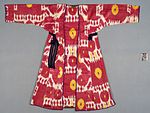chapan (Coat)
About this object
History of use
Ikat robes were worn by men, women and children of various cultures. Women’s robes incorporate extra fullness under the armholes, for wearing ease, and the front opening is typically wide at the chest area, in order to show the lavish jewelry that women often wore. Robes were worn on top of a shirt, tunic or dress and with wide drawstring pants. Several robes may have been worn at once, layered one over another, to display rank and/or wealth. The colourful printed cotton textiles which were typically used to line robes were manufactured in Russia for the Central Asian market, as was the striped bias-cut cotton textile that was used as facings on all the edges (called the lapse). Following the Russian Revolution, the workshops that made ikat robes like this one, which had been organized around family and social networks, were disbanded by the Soviet government, replaced by collective practices in factories. Eventually the making and wearing of ikat robes disappeared.
Narrative
Joanna Staniszkis purchased this robe and most other robes in the 3231 accession in Istanbul, shortly after the dissolution of the USSR; the robes had been previously stored in trunks for a considerable length of time.
Iconographic meaning
The decorative braid or embroidery on all outside edges of ikat robes was believed to be an essential part of the garment, as it prevented evil spirits from infecting the wearer.
Specific techniques
Warp-faced ikat technique. The decorative trim on this robe was produced by a loop manipulation technique, which requires two people working together. One worker holds multiple loops of thread, of various colours, under tension with his fingers, creating warp sheds that are switched between the fingers of one hand and those of the other hand, while another worker inserts a weft into each shed and attaches the threads down onto the surface of the garment with a needle. The result is a multicoloured band with a repeated pattern.
Physical description
Woman’s full-length, A-line, colourful robe or coat with long, tapered sleeves; open at centre front from neck to hem with no closures; front right and left sides do not overlap; made of red, yellow and white warp-ikat textile (silk warp, cotton weft) with a glazed surface; sun disc, ram’s horn and tambourine motifs predominate. There is a vertical opening for a pocket in the right front seam, below the waist; it is bound with 4 cm fringed black and purple braid with yellow and green zigzag trim; the pocket pouch, which is made with red, blue, yellow and white printed cotton textile, is attached to the inside of the robe. A band of wide (3.5 cm) black and purple braid extends from the top of the pocket horizontally under the sleeve to the back of the robe. There is a similar horizontal strip of black and purple braid trim at the same position on the left side, but there is no pocket on the left side. All edges are trimmed on the outside with narrow (5 mm) purple braid make by loop manipulation technique. The edges are faced on the inside with bias strips of machine-printed green, pink and white cotton textile with a floral motif. Vertical slits (12 cm) at the bottom hem on each side. Unlined.
Categories
Materials
Date Made
Before 1900
Date Acquired
20 Mar 2017
How Acquired
Donated
Credit Line
Measurements
Overall: 121 cm x 154 cm
Object Number
3231/15
